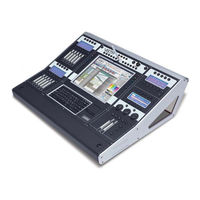Jands Vista T2 Manuals
Manuals and User Guides for Jands Vista T2. We have 1 Jands Vista T2 manual available for free PDF download: User Manual
Jands Vista T2 User Manual (309 pages)
lighting console
Brand: Jands
|
Category: DJ Equipment
|
Size: 4.78 MB
Table of Contents
-
-
Power11
-
Switching on12
-
Main Toolbar19
-
Menu Bar19
-
-
-
The Sidebar27
-
Toolbars28
-
-
-
Channels Tab42
-
-
DMX View43
-
List View43
-
Table View43
-
-
-
-
Layouts53
-
Fan Shapes66
-
-
Fine Mode72
-
Colour Wheel73
-
Swatch73
-
Rotation74
-
Setting Gobo74
-
Focus75
-
Iris75
-
-
-
Colour77
-
Flip77
-
Lee Swatch80
-
Wheel80
-
Gobo81
-
Custom DMX82
-
Beam83
-
Zoom83
-
Framing84
-
-
Groups94
-
Presets95
-
Smartfx99
-
Extracts100
-
Hardware Keypad101
-
-
Using the CLI101
-
Programmer Mode103
-
-
Index104
-
Store All107
-
-
Store Part112
-
-
Cuelist Tabs117
-
Tiles View118
-
Deleting Cues121
-
Merging Cues121
-
Paste Options122
-
Alias Cues123
-
Blocking a Cue124
-
-
-
Cue Properties127
-
Blocking129
-
Tracking129
-
Cue Defaults131
-
Chase Properties134
-
Cuelist Timecode134
-
Cuelist Notes135
-
Timeline Panel135
-
Default Times136
-
-
-
Timeline Events146
-
Changed Events148
-
Snap Events148
-
Muting Events152
-
Effect Types159
-
7 Smartfx
159-
Using Effects159
-
Effect Controls162
-
Rate Control162
-
The Sequence Tab166
-
Advanced Tab168
-
-
-
-
Cuelist Pane181
-
-
Cue Pane182
-
Auto Scroll184
-
Search185
-
-
-
Console Layout187
-
T4 Console187
-
L5 Console188
-
T2 Console188
-
Function Keys189
-
-
Super Fine Mode192
-
Editor Intensity193
-
Editor Live Time193
-
Play Controls193
-
Page Controls198
-
Group Masters205
-
-
Group Fader207
-
Pages207
-
Page Holdover208
-
Snapshots208
-
-
-
File Menu220
-
Edit Menu221
-
Components Menu222
-
Tools Menu222
-
Atch Menu225
-
-
-
Troubleshooting238
-
-
-
Click287
-
Drag287
-
Right Click287
-
-
Double‐Clicking289
-
Dragging289
-
Duoswitch289
-
-
Using a Pen289
-
-
Handling294
-
-
-
Power296
-
Installation297
-
Index301
Advertisement
Advertisement
